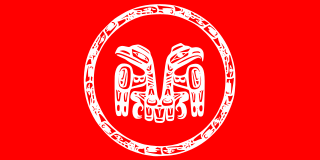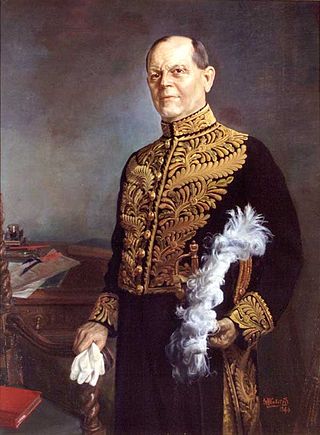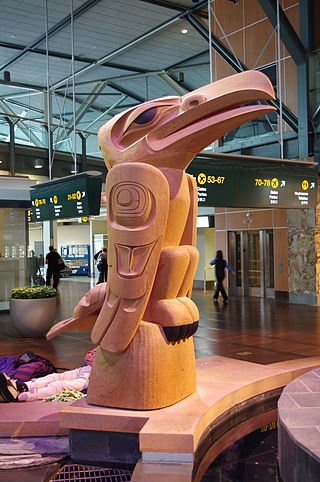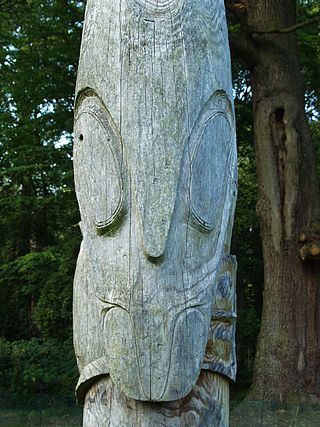
The Haida are an Indigenous group who have traditionally occupied Haida Gwaii, an archipelago just off the coast of British Columbia, Canada, for at least 12,500 years.

Totem poles are monumental carvings found in western Canada and the northwestern United States. They are a type of Northwest Coast art, consisting of poles, posts or pillars, carved with symbols or figures. They are usually made from large trees, mostly western red cedar, by First Nations and Indigenous peoples of the Pacific Northwest Coast including northern Northwest Coast Haida, Tlingit, and Tsimshian communities in Southeast Alaska and British Columbia, Kwakwaka'wakw and Nuu-chah-nulth communities in southern British Columbia, and the Coast Salish communities in Washington and British Columbia.

A talking stick, also called a speaker's staff, is an instrument of Indigenous democracy used by a number of Indigenous communities, especially those in the Pacific Northwest nations of North America. The talking stick may be passed around a group, as multiple people speak in turn, or used only by leaders as a symbol of their authority and right to speak in public.
Roy Henry Vickers, is a Grammy Award nominated Canadian First Nations artist. He owns and operates a gallery in Tofino, British Columbia.

Court uniform and dress were required to be worn by those in attendance at the royal court in the 19th and early 20th centuries.

Robert Charles Davidson, is a Canadian artist of Haida heritage. Davidson's Haida name is G̲uud San Glans, which means "Eagle of the Dawn". He is a leading figure in the renaissance of Haida art and culture. He lives in White Rock, British Columbia.

Dempsey Bob, is a Northwest Coast woodcarver and sculptor from British Columbia, Canada, who is of Tahltan and Tlingit First Nations descent. He was born in the Tahltan village of Telegraph Creek on the Stikine River in northwestern B.C., and is of the Wolf clan.
Freda Diesing was a Haida woman of the Sadsugohilanes Clan, one of very few female carvers of Northwest Coast totem poles and a member of the Council of the Haida Nation of British Columbia, Canada. Her Haida name is Skil Kew Wat, meaning "magical little woman."

Florence Edenshaw Davidson (1896–1993) was a Canadian First Nations artist from Haida Gwaii. She created basketry and button blankets and was a respected elder in her village of Masset, Haida Gwaii, British Columbia.

Northwest Coast art is the term commonly applied to a style of art created primarily by artists from Tlingit, Haida, Heiltsuk, Nuxalk, Tsimshian, Kwakwaka'wakw, Nuu-chah-nulth and other First Nations and Native American tribes of the Northwest Coast of North America, from pre-European-contact times up to the present.
Bill Helin is a Canadian artist, illustrator, jewelry designer engraver, writer, tourism and branding expert, drumming specialist, singing and verbal storyteller; and logo and gift product designer in the Northwest Coast style and a member of the Tsimshian First Nation of northwestern British Columbia. His ancestry is from the Gits'iis tribe in the village of Lax Kw'alaams, B.C. His father was Arthur Helin-(pronounced Hel-een) (Haymaas), was a commercial fisherman and basketball star, was also in Chief lineage in the Gitlan tribe of the Tsimshian Nation.

Norman Tait was a Nisga'a First Nations sculptor and totem pole carver from northwestern British Columbia, Canada.
Dale Campbell is a Canadian First Nations carver from the Tahltan nation of northern British Columbia. Her Tahltan name is Tahlthama which translates to "Tahltan Indian Mother".

Delores E. Churchill is a Native American artist of Haida descent. She is a weaver of baskets, hats, robes, and other regalia, as well as leading revitalization efforts for Haida, her native language.

Chilkat weaving is a traditional form of weaving practiced by Tlingit, Haida, Tsimshian, and other Northwest Coast peoples of Alaska and British Columbia. Chilkat robes are worn by high-ranking tribal members on civic or ceremonial occasions, including dances. The blankets are almost always black, white, yellow and blue.

Kwakwaka'wakw art describes the art of the Kwakwaka'wakw peoples of British Columbia. It encompasses a wide variety of woodcarving, sculpture, painting, weaving and dance. Kwakwaka'wakw arts are exemplified in totem poles, masks, wooden carvings, jewelry and woven blankets. Visual arts are defined by simplicity, realism, and artistic emphasis. Dances are observed in the many rituals and ceremonies in Kwakwaka'wakw culture. Much of what is known about Kwakwaka'wakw art comes from oral history, archeological finds in the 19th century, inherited objects, and devoted artists educated in Kwakwaka'wakw traditions.
Dorothy Grant is an Indigenous fashion designer whose works have gained public recognition as expressions of living Haida culture.

The Totem Heritage Center is a historical and cultural museum founded in 1976 and located in Ketchikan, Alaska. The center is operated by the city of Ketchikan.
Doreen Jensen, also known as Ha'hl Yee, was a Gitsxan elder, artist, carver, activist and educator.

Ravenstail weaving, also known as Raven's Tail weaving, is a traditional form of geometric weaving-style practiced by Northwest Coast peoples.














